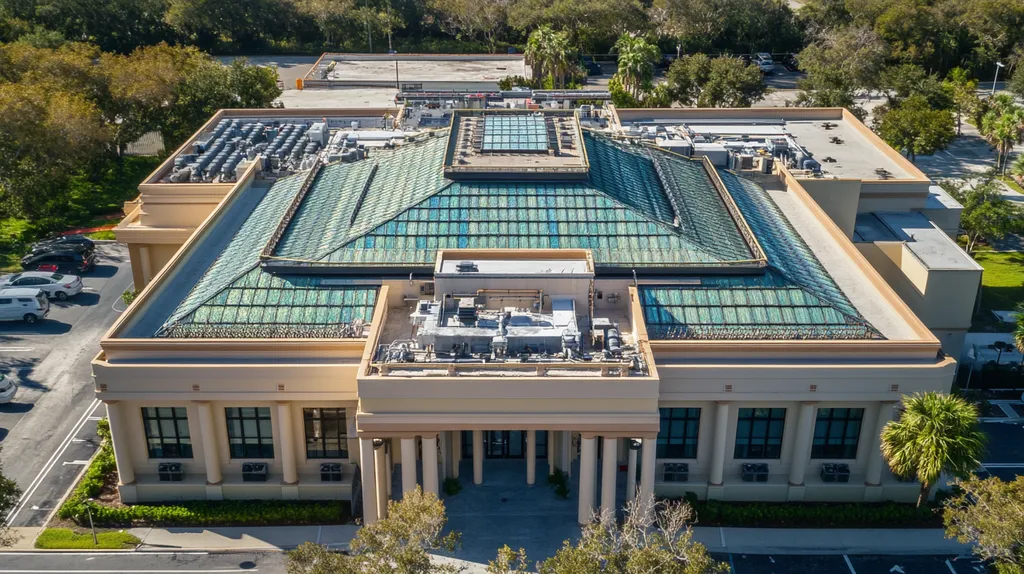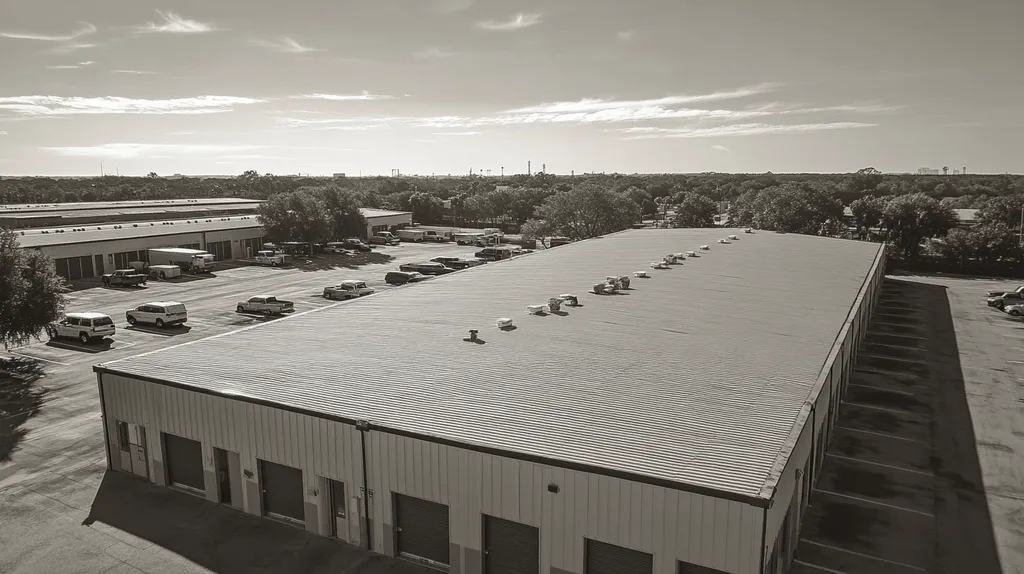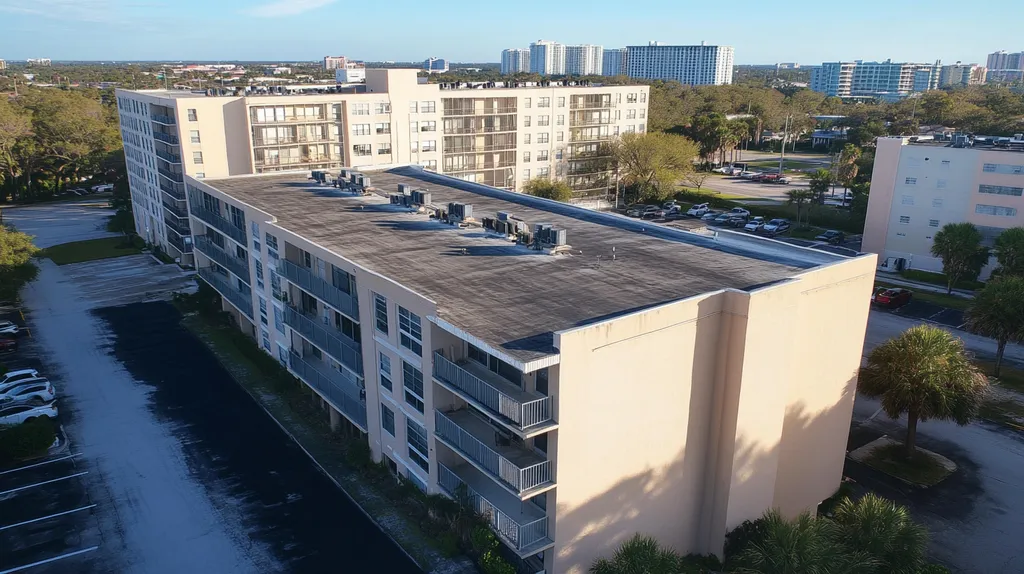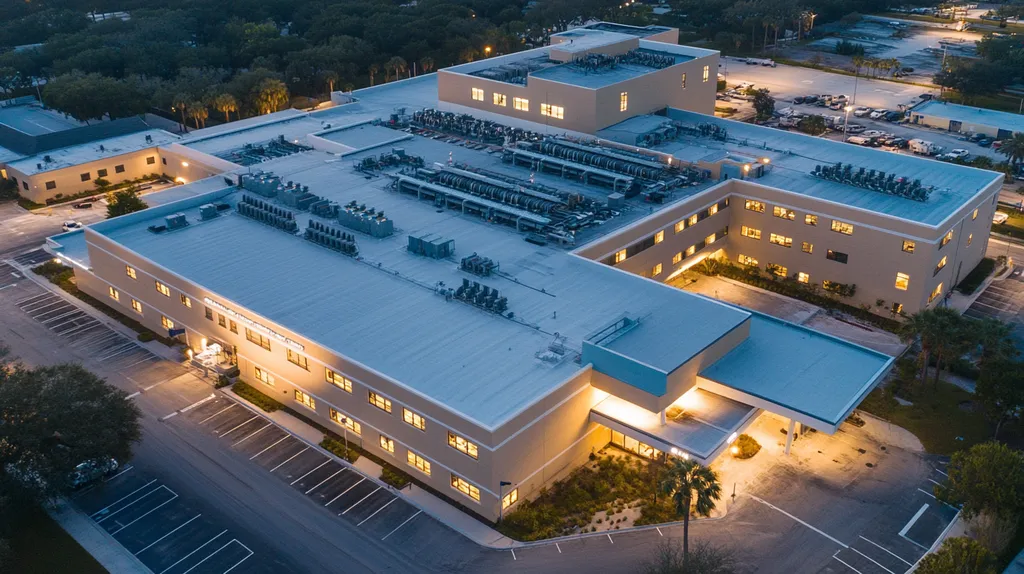As energy costs soar and climate concerns intensify, commercial building owners face mounting pressure to reduce their environmental impact. Studies show that uncoated roofs can absorb up to 95% of solar energy, turning buildings into massive heat sinks.
While roof coatings promise a simple solution, the reality is more complex than the marketing hype suggests. From reflectivity ratings that don’t deliver to applications that fail prematurely, misinformation costs property owners millions annually.
This guide cuts through the confusion to reveal what actually works, what doesn’t, and why getting it right matters more than ever for your bottom line and the planet.
SECTION 1: COMMON MISCONCEPTIONS
Picture this: Your commercial roof is up there right now, battling the elements while trying to keep your energy bills in check. With rising environmental concerns and soaring utility costs, many building owners are rushing to roof coatings as their environmental superhero. But before you join the coating crusade, let’s bust some myths that could cost you time, money, and peace of mind.
Roof Coatings Instantly Solve All Environmental Issues
Think of roof coatings like sunscreen – they’re great at what they do, but they won’t fix that sunburn you got yesterday. While coatings can definitely boost your building’s green credentials, they’re not environmental cure-alls.
That mysterious puddle in the corner? A coating won’t make it disappear. And those sky-high heating bills? They might have more to do with your 1970s insulation than your roof’s reflectivity.
The real magic happens when coatings are part of a well-planned sustainability strategy. Like a talented backup singer, they enhance the performance but shouldn’t be expected to carry the whole show.
Success requires addressing underlying issues first – think of it as giving your roof a proper checkup before sending it to the spa.
Coatings Always Eliminate the Need for Roof Replacement
Believing a coating can save every roof is like thinking a fresh coat of paint will fix a car with a blown engine. While coatings can extend the life of healthy roofs, they can’t resurrect one that’s ready for retirement.
Some roofs are simply too far gone. Slapping a coating on severely damaged materials is like putting a Band-Aid on a broken arm – it might look like you’re doing something, but you’re not solving the real problem.
Smart building owners know when to coat and when to replace. The key is honest assessment: if your roof has more patches than original material, it’s probably telling you something important.
Consider coatings as life extenders for worthy roofs, not miracle workers for failing ones. When in doubt, get a professional assessment before making this crucial decision.
Reflectivity Guarantees Major Energy Savings in Every Case
Hold onto your utility bills, folks! While reflective coatings can be energy-saving superstars, they’re not one-size-fits-all solutions. The United States Environmental Protection Agency confirms that in air-conditioned buildings, cool roofs can reduce peak cooling demand by 11-27%.
But here’s the catch: your mileage may vary dramatically. That shiny new coating might be a rockstar in Phoenix but more like a backup dancer in Seattle. Climate, building design, and existing insulation all play starring roles in this performance.
Your building’s orientation matters too. A roof taking the full force of the afternoon sun will benefit more from reflectivity than one shaded by neighboring skyscrapers.
The smart money is on getting a professional energy audit before investing in reflective coatings. This way, you’ll know exactly what kind of return on investment to expect. (source: EPA)
SECTION 2: PRACTICAL IMPLICATIONS
Your commercial roof isn’t just lounging around up there – it’s engaged in an epic battle against the elements while trying to keep your utility bills from skyrocketing. Think of it as your building’s personal superhero, capable of reflecting solar rays, fighting off storms, and even helping cool entire neighborhoods. But like any superhero, it needs the right equipment to perform at its peak.
Energy Efficiency Gains and Cooling Load Reduction
Imagine your roof as a massive solar shield, either absorbing or reflecting the sun’s energy. Without proper coating, it’s like wearing a black jacket on a summer day – you’re going to feel the heat.
The right coating transforms your roof into an energy-saving powerhouse. It’s like giving your building a refreshing drink of ice water, keeping indoor temperatures comfortable without overworking your HVAC system.
Cool roofs can reduce peak cooling demand by 11-27%, slashing both energy bills and greenhouse gas emissions. This isn’t just good for your bottom line – it’s a boost for air quality and community health. (source: EPA)
The best part? These savings compound over time, making every sunny day an opportunity to bank more energy dollars.
Roof Longevity and Protection from Weather Damage
Think of roof coating as your building’s suit of armor. It battles UV rays, deflects raindrops, and stands guard against temperature extremes that can wreak havoc on unprotected surfaces.
This protective layer doesn’t just defend – it extends your roof’s lifespan. Without it, your roofing materials age like a car left out in the desert sun, rapidly deteriorating under harsh conditions.
The coating fills in minor cracks and creates a seamless barrier, preventing those tiny problems from becoming expensive headaches. It’s like having a self-healing shield that keeps water where it belongs – outside your building.
Plus, a well-maintained coating can double the functional life of your roofing system, turning what could be a costly replacement into a manageable maintenance schedule.
Urban Heat Island Mitigation through Reflective Surfaces
Cities are getting hotter, and traditional dark roofs are partly to blame. They’re like thousands of solar ovens cooking our urban areas to uncomfortable – and sometimes dangerous – temperatures.
Reflective coatings flip this script by bouncing solar energy back into space instead of absorbing it. One coated roof might seem small, but multiply that effect across a city, and you’ve got a powerful weapon against urban heat.
When buildings work together with reflective surfaces, they create cooler microclimates that benefit everyone. It’s like having thousands of tiny air conditioners working at the neighborhood level.
The impact goes beyond comfort – cooler cities mean lower energy demands, reduced air conditioning costs, and healthier communities. Many local governments now offer incentives for installing reflective coatings, making it easier to be part of the solution.
SECTION 3: COST OF MISINFORMATION
When it comes to roof coatings, what you don’t know can definitely hurt your bottom line. Imagine discovering your projected energy savings were off by 50%, or watching your fresh coating peel away because someone skipped a crucial preparation step. These aren’t just minor setbacks – they’re budget-busting blunders that can turn your sustainability solution into a financial sinkhole. Let’s explore the hidden costs of getting it wrong, and more importantly, how to get it right.
Hidden Financial Risks of Overestimated Energy Savings
Think of energy savings predictions like weather forecasts – they’re useful guides, but not guarantees. While rubberized roof coatings can significantly reduce energy consumption through sunlight reflection, the actual savings vary dramatically based on your building’s specific conditions. (source: Karnak)
The math gets tricky when marketing hype meets reality. A promised 40% reduction in cooling costs might actually deliver only 15-20%, leaving you with a significant budget shortfall.
Location matters more than many realize. That amazing case study from Phoenix won’t translate directly to your building in Chicago, where heating costs might actually increase with a highly reflective coating.
Smart building owners focus on total return on investment, not just energy savings. Factor in maintenance costs, application expenses, and the potential need for recoating when building your budget.
Costs from Ignoring Roof Condition Before Coating
Applying a coating to a compromised roof is like painting over rust – it might look better temporarily, but you’re just hiding the problem. And hidden problems have a nasty habit of becoming expensive emergencies.
Water trapped beneath your roofing membrane won’t magically evaporate when you add a coating. Instead, it’ll continue degrading your roof system, potentially leading to structural damage that costs 10 times more to fix than proper preparation would have.
Those tiny blisters and cracks you can barely see? They’re like tiny time bombs for your coating investment. Each one represents a potential failure point that could turn your coating project into a costly do-over.
The solution? Think of roof preparation like foundation work for a house – skip it at your peril. A thorough inspection and necessary repairs before coating might seem expensive, but they’re bargains compared to the alternative.
Expense of Frequent Repairs Due to Improper Application
Your roof coating is only as good as the person applying it. Temperature, humidity, surface preparation, and application thickness all play crucial roles in success or failure.
When corners get cut during application, problems multiply faster than rabbits. A coating applied too thin might save money initially but will likely fail in half the expected time, doubling your long-term costs.
Weather timing matters more than many realize. Apply your coating on a humid day or just before rain, and you might as well be throwing money off the roof – literally.
The real kicker? Most coating failures aren’t covered under warranty if they’re traced back to improper application. That means every repair comes straight from your maintenance budget, creating a financial drain that could have been avoided.
SECTION 4: REALITY CHECK
Your commercial roof is up there playing matchmaker between the sun and your building – but this relationship status? It’s complicated. While roof coatings can be environmental heroes, they’re more like specialized agents than universal superheroes. Each roof type has its own personality, and matching the wrong coating to your roof is like sending a snowboard champion to surf Pipeline – technically possible, but probably not going to end well.
Limits of Coating Performance Based on Roof Type
Picture your roof as a dance floor – some surfaces are perfect for the waltz, others better suited for breakdancing. Single-ply membranes like TPO practically roll out the red carpet for reflective coatings, creating a smooth, receptive surface that maximizes performance.
Meanwhile, modified bitumen roofs can be the awkward dancers of the coating world. Their rough, uneven surface might reject certain coatings faster than a teenager ghosting a bad date, leading to bubbling, peeling, and premature failure.
Metal roofs bring their own quirks to the party. They expand and contract like an accordion in changing temperatures, demanding coatings flexible enough to keep up with their moves without cracking or separating.
Built-up roofs (BUR) need special consideration too. Their multiple layers can trap moisture, making them particularly picky about which coatings they’ll play nice with.
Environmental Impact Depends on Quality and Maintenance
Cool roof coatings can lower surface temperatures by up to 55°F compared to traditional gray roofs, making them environmental superstars when properly maintained. They’re not just cooling your building – they’re fighting urban heat islands and reducing carbon footprints one reflection at a time. (source: Roof Coatings.org)
But like a high-performance athlete who skips training, neglected coatings quickly lose their edge. Dirt, debris, and damage can transform your reflective coating from an environmental champion into just another layer of roofing material.
Quality matters more than many realize. Premium coatings might cost more upfront, but they’re like investing in a reliable car instead of a series of clunkers – the long-term savings in both money and environmental impact make the initial investment worth it.
Regular cleaning and maintenance aren’t optional extras – they’re as essential as changing your car’s oil. A well-maintained coating keeps performing at peak efficiency, while a neglected one becomes part of the problem it was meant to solve.
Necessity of Professional Assessment and Preparation
DIY might work for painting your office, but roof coatings? That’s like trying to perform your own root canal. Professional assessment isn’t just about checking boxes – it’s about understanding the complex relationship between your roof, its environment, and the coating system.
Surface preparation is the secret sauce of successful coating applications. Skipping this step is like trying to stick a bandage on wet skin – it might stay put for a minute, but it won’t last long enough to do its job.
Professionals bring more than just expertise – they bring specialized equipment and testing methods that can spot potential problems invisible to the untrained eye. They’re like building doctors, diagnosing issues before they become expensive emergencies.
The right assessment can also prevent you from coating a roof that really needs replacement, saving you from throwing good money after bad. Sometimes the best coating decision is no coating at all.
SECTION 5: EVIDENCE-BASED ALTERNATIVES
Your commercial roof is like a tired superhero who needs the right gear to keep fighting crime. While it’s up there battling UV rays and deflecting rain, outdated solutions are forcing it to work harder than necessary. Modern coating alternatives don’t just promise better performance – they deliver it with scientific precision. Let’s explore how evidence-based solutions can transform your roof from an energy-draining liability into a sustainable powerhouse.
Cool Roof Coatings with Proven Reflectivity Ratings
Think of your roof as a mirror – the more sunlight it reflects, the less heat your building absorbs. Cool roof coatings can reduce surface temperatures by up to 55°F compared to traditional gray roofs, turning your energy-hungry roof into a climate control ally. (source: Roof Coatings.org)
Not all reflective coatings are created equal. The best ones come with independently verified Solar Reflectance Index (SRI) ratings, taking the guesswork out of performance predictions.
These high-tech coatings work like a building-sized sun umbrella, bouncing away heat before it can sneak into your space. The result? Lower cooling costs and happier HVAC systems.
Modern cool roof solutions offer options beyond traditional white. Today’s coatings come in various colors while maintaining their reflective superpowers, proving you don’t have to sacrifice style for efficiency.
Use of Sustainable, Low-VOC Materials in Coatings
Remember when “going green” meant sacrificing performance? Those days are gone. Today’s sustainable coatings pack more punch than their traditional chemical-heavy ancestors while being kinder to the environment.
Low-VOC coatings are like ninja warriors – they get the job done without leaving a trace. They protect your roof just as effectively as conventional options but without releasing harmful compounds into the air.
These eco-friendly alternatives often last longer too, thanks to advanced polymer technology that stands up to weather extremes. It’s like giving your roof armor that actually gets stronger with age.
The best part? Many sustainable coatings now cost the same or less than their traditional counterparts, making the choice between environmental responsibility and budget constraints much easier.
Combining Coatings with Roof Repairs for Optimal Results
Applying a coating without fixing underlying issues is like putting a Band-Aid on a broken arm. Smart building owners know that preparation is everything when it comes to maximizing coating performance.
Start with a thorough inspection to catch hidden problems. Those tiny cracks and loose seams might seem minor now, but they’re like tiny time bombs waiting to compromise your coating investment.
Strategic repairs combined with coating application create a dynamic duo of protection. The repairs address current vulnerabilities while the coating prevents new ones from developing.
This tag-team approach often costs less in the long run than dealing with repeated coating failures or emergency repairs. Plus, it extends your roof’s lifespan, keeping more materials out of landfills and more money in your pocket.
SECTION 6: TEST AND VERIFY
Think of your commercial roof coating like a star athlete – impressive stats are nice, but game-day performance is what really counts. Without proper testing and verification, those glossy marketing promises about energy savings and environmental benefits are about as reliable as a weather forecast from last month. Let’s explore how to turn vague coating claims into measurable results that actually benefit your bottom line and the planet.
Measuring Solar Reflectance and Thermal Emittance
Solar reflectance testing is like giving your roof a report card on its sun-blocking abilities. Modern reflectometers can tell you exactly how much solar energy your coating is bouncing back into space instead of letting it sneak into your building.
Thermal emittance, meanwhile, measures how effectively your roof releases heat – think of it as your building’s ability to “exhale” absorbed warmth. The Roof Coatings Manufacturers Association confirms that quality reflective coatings can reduce surface temperatures by up to 55°F compared to traditional dark roofs. (source: Roof Coatings.org)
Regular testing helps catch performance drops before they impact your energy bills. It’s like having a fitness tracker for your roof, monitoring its environmental performance 24/7.
The best part? These measurements provide concrete data for sustainability reports and green building certifications, turning your roof into a documented environmental asset.
Conducting Energy Usage Comparisons Pre and Post Application
Before-and-after energy comparisons are like getting a full-body scan of your building’s metabolism. They reveal exactly how much that shiny new coating is contributing to your bottom line.
Smart facility managers track at least three months of pre-coating energy data to establish a reliable baseline. This creates a clear “before” picture against which to measure improvements.
Weather-normalized comparisons are crucial – comparing August to January is like measuring sprinting speed uphill versus downhill. Use energy management systems that account for temperature variations to get truly accurate results.
Don’t forget to factor in other variables like occupancy changes or new equipment installations. They’re like background noise that needs filtering out to hear your coating’s true performance song.
Regular Inspection and Recoating Schedules for Longevity
Think of roof coating maintenance like dental checkups – regular visits prevent painful emergencies. Even the best coatings need periodic inspection to catch wear and tear before it compromises performance.
Create a calendar-based inspection schedule that accounts for your local climate challenges. Desert installations might need more frequent checks than coastal ones, just like your car needs different maintenance in different environments.
Document everything during inspections – photos, measurements, and notes about potential trouble spots. These records are like your roof’s medical history, helping track changes over time and predict future needs.
Plan recoating operations before your current coating hits its performance cliff. Most systems need renewal every 5-10 years, but local conditions and coating quality can shift that timeline dramatically.
The Bottom Line
With commercial buildings accounting for 35% of U.S. energy consumption, roof coating decisions impact both corporate profits and environmental health.
While coatings aren’t universal solutions, properly selected and maintained systems can reduce roof surface temperatures by up to 55°F and cut cooling costs by 11-27%.
Success requires moving past marketing hype to embrace evidence-based solutions, professional assessment, and regular maintenance.
The stakes are clear: businesses that ignore coating best practices face escalating energy costs, premature roof failure, and missed sustainability targets.
As urban heat islands intensify and energy costs rise, smart coating strategies aren’t just good business – they’re essential for future-proofing commercial properties in an increasingly warming world.
FREQUENTLY ASKED QUESTIONS
Q. Do commercial roof coatings solve all environmental issues?
A. Not at all! While they improve your building’s green credentials, coatings aren’t magic solutions. They work best as part of a comprehensive sustainability strategy, addressing existing problems first. Think of them as enhancements, rather than cure-alls.
Q. How do coatings affect the cooling load of an industrial roof?
A. With the right coating, your roof acts like a giant energy shield, reflecting excess heat and lowering indoor temperatures. This can significantly reduce cooling demand and energy bills, creating a win-win for your facility and the environment.
Q. Can a coating replace the need for roof repairs?
A. Unfortunately, no. Coatings can’t remedy underlying issues like significant damage or leaks. Think of coatings as protective layers that extend the life of a well-maintained roof, but they shouldn’t be expected to act as a fix-all for existing problems.
Q. Are all commercial roof coatings the same?
A. Nope! Different roof types require specific coatings tailored to their unique materials and conditions. Using the wrong coating can lead to peeling and bubbling, just like mismatched dance partners. Always choose wisely to ensure the best results!
Q. What are the financial risks of misestimating energy savings?
A. If energy savings projections are overly optimistic, it can lead to budget shortfalls. You might expect higher savings but end up with less, causing painful impacts on your bottom line. Always consult professionals to get accurate assessments.
Q. How do I measure the effectiveness of my coating?
A. Regular testing of solar reflectance and thermal emittance can provide accurate insights into your coating’s performance. Keeping track of energy usage before and after application helps gauge its effectiveness. This approach ensures that your coating lives up to its promises!
Q. Are there sustainable alternatives to traditional coatings?
A. Absolutely! Many modern coatings utilize low-VOC materials that are environmentally friendly and effective. They offer great performance without the harmful chemicals, proving sustainable options are both possible and cost-effective.










